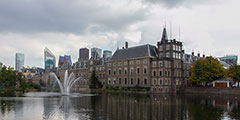Gevers Deynootplein 30, 2586 CS, The Hague
The suite of Bertha von Suttner in the Kurhaus remains a source of inspiration for peace activists and committed diplomats, reflecting over a century of hopes, disappointments and new initiatives for peace and international justice.
“Farewell, lovely city of parks and gardens! That this place, where the first international arbitration court originated, may become the pilgrimage place for future generations”
– Bertha von Suttner (Nobel Peace Prize 1905)
Baroness Bertha von Suttner was the driving force behind the international peace movement at the end of the 19th century. Her bestseller “Lay Down Your Arms (Die Waffen nieder)”, first published in 1889, helped to mobilize pacifist public opinion under her slogan “Hail to the future!”
Von Suttner first came to The Hague in 1894, invited by the Dutch government to attend the conference of the Inter-Parliamentary Union in the Hall of Knights. In Von Suttner’s experience, the real political results were gained during dinners and receptions in her Kurhaus suite. Her informal diplomacy also helped to create international support for the disarmament initiative that Tsar Nicholas II launched in 1898.
“To the place where peace will be born”, Von Suttner wrote about the First Hague Peace Conference in 1899 to Zionist leader Theodor Herzl, editor of the Austrian newspaper Die Welt. Apart from her Kurhaus suite, she held a salon near the parliament buildings in the former Grand Hotel Central (now demolished). Her receptions connected pacifist opinion leaders such as Jan Bloch and William T. Stead with “the circles that happen to have power in their hands.”
But Von Suttner left the conference early, disappointed by the failed disarmament talks: “There is reason to be sad. Cold, cold are all hearts. Cold like the icy sky, that blows in through the clattering windows. I shudder.”
This experience strengthened Von Suttner’s determination to ‘persist, persist and continue to persist’. Her persistence motivated her friend Alfred Nobel, for whom she had worked in Paris, to support the peace movement with a permanent award. In 1905 she was the first woman to receive the Nobel Peace Prize herself. Von Suttner also inspired Andrew Carnegie to finance the Peace Palace. At the centenary celebration in 2013, she was the first woman honoured with a bust in the ‘Temple of Peace’.
As Von Suttner hoped, The Hague has become a ‘pilgrimage place for future generations’. One of her successors is the American peace and human rights campaigner Cora Weiss, former President of the International Peace Bureau (Nobel Peace Prize 1910). At the centenary of the First Hague Peace Conference in 1999, Weiss presided the Hague Appeal for Peace with almost 10.000 participants, and which launched an ongoing global campaign for peace education.







 16 minutes with tram 9 from Nieuwe Duinweg
16 minutes with tram 9 from Nieuwe Duinweg






